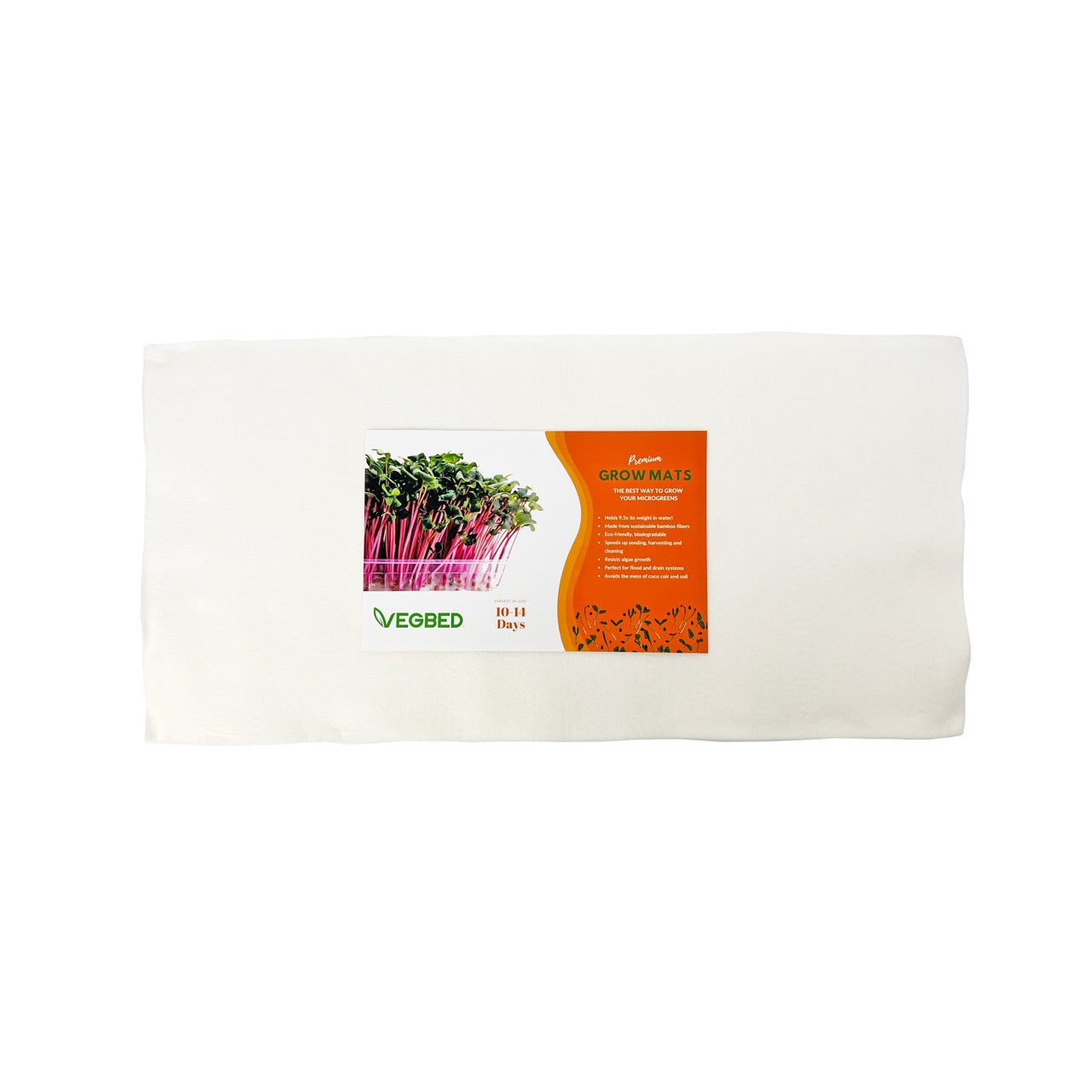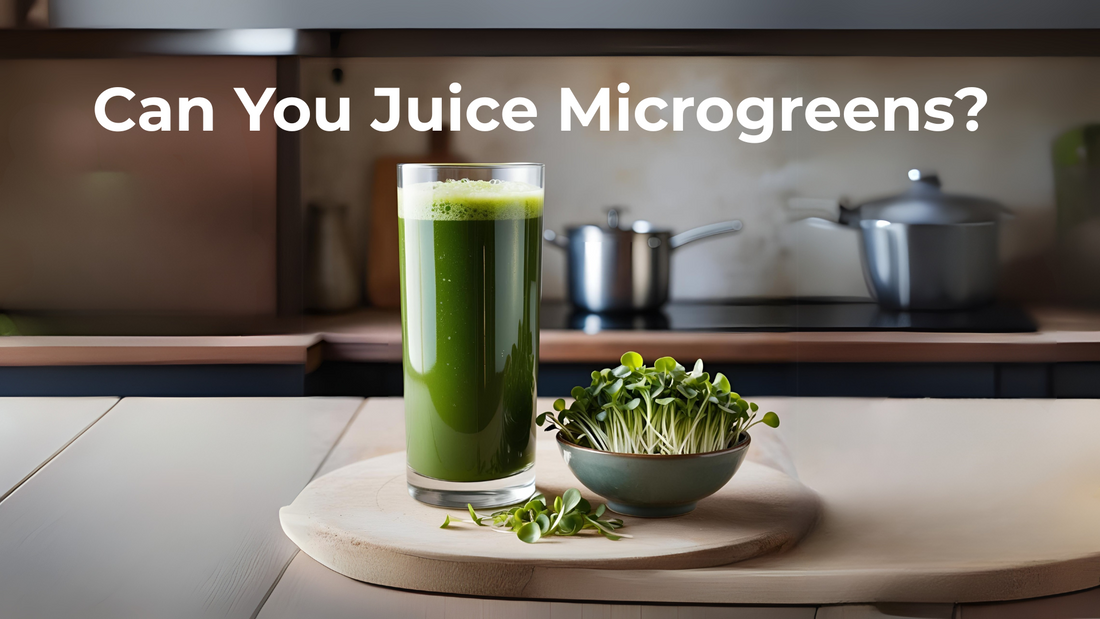If you’ve been blending up green smoothies or reaching for wheatgrass shots, you may have wondered: Can you juice microgreens? The short answer? Absolutely.
Microgreens have long been celebrated for their concentrated nutrients, distinct flavors, and culinary versatility—but now, they’re gaining traction as a top-tier juicing ingredient. With the rising demand for fresh, functional nutrition, more home growers and health enthusiasts are turning to microgreens not just for garnishes, but for green elixirs.
In this blog, we’ll walk you through everything you need to know about juicing microgreens—from the best varieties to juice, to flavor profiles, health benefits, tips for preparation, and even how Vegbed’s bamboo mats make it safer and cleaner to grow microgreens for juicing.
What Are Microgreens?
Microgreens are the young seedlings of vegetables and herbs, harvested just after the cotyledon (first) leaves develop, usually within 7–21 days of germination. Despite their tiny size, they pack a powerful nutritional punch, often containing 4–40x the nutrient levels of their mature counterparts.
Why Juice Microgreens Instead of Eating Them?
While microgreens are fantastic raw or cooked, juicing them offers:
-
Nutrient density in a concentrated form
-
Faster absorption by the body
-
A refreshing alternative to wheatgrass or spinach-based green juice
-
Great option for people with chewing difficulties or digestive concerns
Best Microgreens for Juicing
Not all microgreens are ideal for juicing. The key is balancing flavor, nutrient profile, and yield. Here are the best juicing contenders:
|
Microgreen |
Flavor Profile |
Health Benefits |
|
Sunflower |
Mild, nutty |
Rich in B vitamins, protein, and antioxidants |
|
Pea Shoots |
Sweet, grassy |
High in Vitamin C, folate, and fiber |
|
Broccoli |
Mildly peppery |
Contains sulforaphane—anti-inflammatory and anti-cancer compound |
|
Wheatgrass |
Sweet, earthy |
Detoxifying, rich in chlorophyll |
|
Radish |
Spicy, pungent |
High in Vitamin E and immune-boosting compounds |
|
Fenugreek |
Bitter, earthy |
Blood sugar regulation, iron-rich |
|
Cilantro & Parsley |
Herbal, sharp |
Detox, heavy metal cleansing properties |
You can also blend them with fruits (like apples, oranges, pineapple) or cucumber/celery for a more palatable experience.
Health Benefits of Juicing Microgreens
Juicing microgreens isn't just trendy—it’s a nutrient-dense habit backed by science. Here are some of the most talked-about benefits:
1. Boosts Immunity
Microgreens like broccoli, kale, and radish are loaded with vitamins C, E, and K—essential for immune system strength.
2. Supports Detoxification
Varieties like wheatgrass, cilantro, and parsley are popular in detox blends due to their chlorophyll and antioxidant content.
3. Improves Digestion
Some microgreens, particularly sunflower and fenugreek, are fiber-rich and support healthy digestion and gut flora.
4. Anti-Inflammatory Properties
Sulforaphane in broccoli microgreens and flavonoids in pea shoots help fight inflammation, a root cause of many chronic diseases.
How to Juice Microgreens at Home
Juicing microgreens is easy with the right equipment:
🥤 What You’ll Need:
-
Cold press juicer or masticating juicer (best for leafy greens)
-
Fresh microgreens (harvested the same day)
-
Optional: lemon, apple, cucumber, ginger
🧼 Prep Tips:
-
Rinse thoroughly in cool water.
-
Pat dry with a clean towel or spin in a salad spinner.
-
Trim any roots (especially if using mats—no soil to worry about with Vegbed).
-
Juice immediately to preserve nutrients.
Juicing vs. Powders vs. Whole Microgreens
You’ve likely seen powdered microgreens or wheatgrass shots at health food stores. Here’s how they compare:
|
Format |
Pros |
Cons |
|
Fresh Juice |
Highest nutrient absorption, cleanest taste |
Short shelf life |
|
Powdered Microgreens |
Convenient, long shelf life |
Lower nutrient retention, often heat-processed |
|
Whole Microgreens (eaten) |
Fiber retained, freshest |
Less concentrated nutrients vs. juice |
Verdict:
For the best nutritional impact and taste—fresh juice reigns supreme. And if you’re growing your own microgreens using Vegbed’s pathogen-free mats, you know exactly what’s going into your glass.
Why Safety Matters When Juicing Microgreens
When consuming any raw greens—especially in juice form—food safety is critical.
That’s where Vegbed gives you the upper hand. Our bamboo fiber grow mats are:
✅ 99% Pathogen-Free (as confirmed by our latest Pathogen Plus testing)
✅ Inert and food-safe (Oeko-Tex 100 certified and FDA compliant)
✅ Soil-free and biodegradable—no soil contamination, no composting required
🌱 Freshness means nothing without safety. And Vegbed mats give you both.
Sample Juice Recipe: Immune Boosting Microgreen Shot
Ingredients:
-
1 cup sunflower microgreens
-
1/2 cup pea shoots
-
1 inch fresh ginger
-
1 apple
-
Juice of 1 lemon
Instructions:
-
Rinse and dry your microgreens.
-
Chop apple and ginger into smaller chunks.
-
Run everything through a slow juicer.
-
Serve immediately. Cheers to your health!
Final Thoughts
So, can you juice microgreens? Not only can you, but you should.
Microgreen juicing is an exciting, nutrient-dense way to fuel your body with powerful phytonutrients, without the fillers or synthetic additives found in many green powders or supplements.
By growing with Vegbed’s ultra-clean bamboo mats, you’re not just growing better microgreens—you’re unlocking safer, smarter, and tastier ways to enjoy them.
Ready to take the shot?
Start with fresh, safe microgreens—and let Vegbed be your clean growing partner.



